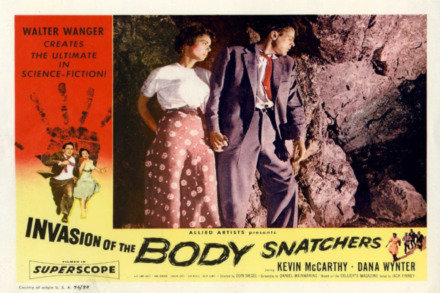uring the Golden Age of Hollywood, which began with the advent of the talkies in the late 1920s, movie studios released what were known as the B Movies.
Paired with a full-length film to give the audience a double-feature movie experience, the B Movie was shorter in duration, produced with a low budget, and received little or no publicity.
Horror/science fiction B Movies were popular with moviegoers at the time of their release and many have become classics that remain in vogue today. Filmed in 1956, Invasion of the Body Snatchers is one of the best of those films that begins with an ominous shadow slowly creeping over the lives of ordinary people going about their everyday activities.
Called back to his small hometown from a convention, Dr. Miles Bennell (Kevin McCarthy) notices a disturbing change in his neighbors and patients.
A vegetable stand has been abandoned by its owner; Jimmy, a preteen boy, is panicky and refuses to go to school; patients with mysterious complaints have cancelled their appointments claiming to be symptom free.
When Jimmy arrives at Miles’s office with his grandmother he insists that his mother is not herself. Becky Driscoll (Dana Wynter), Miles’s high school sweetheart, is concerned for her cousin Wilma, who insists that her Uncle Ira is an imposter. This man ‘looks, sounds, acts, and remembers’ the same, but his eyes are blank, without feeling.
When Miles consults the town psychiatrist, Dr. Dan Kauffman, about his patients’ accusations, he learns that other townspeople are afflicted by the same delusion. Dan hypothesizes that they are suffering from mass hysteria caused by the worries of world events.
Becky, like most female supporting characters in the fifties science fiction movies, is playing second fiddle to Miles. We know romance is in the air immediately upon seeing Becky in her snazzy sundress exposing rippling tulle at the low neckline. A blossoming romance lends a modicum of lightness to these intense movies.
Hoping that he and Becky, who like Miles has recently divorced, can rekindle their relationship, Miles asks Becky to dinner. But before they order, Miles receives a call. Jack Belicec and his wife, Teddy, have discovered a body in their house.
When Miles examines the body, he notices that it appears to be the same size and build as Jack, but its facial features are vague, as if they have not yet fully developed. Before Miles leaves he asks the Belicecs to call him if they see any change in the body.
In the wee hours of the morning Teddy sees the body open its eyes and notices that its features look exactly like Jack‘s. Frightened, they drive to Miles’s house. Realizing the implications of the recent events in his community, Miles becomes alarmed for Becky.
He races to her house and breaks into a basement window. In a bin he finds a body wrapped in a blanket, and this time it’s a body that looks like Becky. Upstairs he is unable to awaken Becky. He picks her up and carries her to his home.
After calling Dan, Miles and Jack return to Becky‘s house, and in their panic they glance into the dark bin and imagine a body. But it isn’t there. The body has disappeared. Dan tries to convince Miles and Jack that there was no body in Becky’s basement. He tells them that they, too, are suffering from hysteria.
A frequent element in early science fiction films is the persistent propensity for people of authority to fail to take seriously the perceptions of those seeking their protection. When Miles is confronted with this dismissive behavior from the authorities, he soon learns there is a sinister reason for their abrogative attitude.
When we next see Wilma and Jimmy they appear to have recovered from their hysteria. Wilma, like others in the community, has become dispassionate. Miles remarks that he has seen people’s humanity drain away, their hearts hardened over time, little by little. But now there is a ‘disease spreading through the country.’
When four vegetable-like pods containing bodies with characteristics of Miles, Becky, and the Belicecs are discovered in Miles’s greenhouse, Miles decides it’s time to call for outside help. But whom can they trust?
Invasion of the Body Snatchers takes for granted that fear of worldly events can cause hysteria. Likewise, when danger threatens a loved one, hysteria can overcome an otherwise sensible person.
However, as demonstrated in the scene in Becky’s basement, hysteria can impede rational thinking and does little to influence others and keep one safe.
The opposite extreme to emotional instability is to surrender to aloofness, to close our hearts to the concerns and misfortunes of others in order to save ourselves from fear and discomfort.
As demonstrated in Miles’s office fear and its byproduct, righteous anger, when controlled can be used to fuel investigative efforts and positive action.
Sadly, we learn that falling asleep or becoming disengaged, i.e., becoming apathetic will halt critical thinking, giving the illusion that all is well. Instead, that state of mind allows stronger willed persons to take control and direct the course of events.
The movie was adapted from Jack Finney’s book, The Body Snatchers, which was revised in 1978 and renamed The Invasion of the Body Snatchers.
Miles’s screams on the highway near the end of the movie are so riveting that the viewer can be forgiven for checking her street for large trucks carrying pods, particularly if she is Jimmy‘s age.
Like Becky, you may wonder what happens to the original bodies. For that answer you will need to read the book. This production is the first of five adaptations of Finney’s novel. Several parodies have also been produced.
Read more: http://www.femalefirst.co.uk/movies/invasion-of-the-body-snatchers-movie-classics-406619.html#ixzz2r5naI0EI

